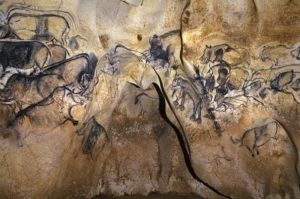
CNRS—The oldest signs of man-made fire date back about 400,000 years. Hundreds of thousands of years later, at around 40,000 BCE, Homo sapiens, having mastered the flickering flame, began dwelling in caves seasonally. These humans left behind them rock art, proof of their former occupancy. Chauvet Cave (Grotte Chauvet–Pont d’Arc), a UNESCO World Heritage site, bears faithful testimony of the very beginnings of cave art. A study* bringing together several CNRS researchers1 has examined wood charcoal left by humans of the Aurignacian (37,000–33,500 BCE) and Gravettian (31,000–28,000 BCE) cultures who frequented the Chauvet–Pont d’Arc site. Of the 171 samples studied by the scientists, all but one are derived from pine trees. The presence of these conifers indicates a cold, dry climate and steppe interspersed with pine, birch, and juniper groves. Pine would have been burnt for the large flames it produces, illuminating the cave walls while the prehistoric artists executed their works. Some of the fire pits found at the cave were used solely to produce pine charcoal for use in the paintings.
_____________________________

© C. Fritz / Chauvet Team / MC
These findings are published in Antiquity (April 25, 2018).
Article Source: A CNRS news release.
1.Researchers at the following organizations::
– Laboratory Cultures et environnements. Préhistoire, Antiquité, Moyen Âge (CEPAM) (CNRS/Université Nice Sophia Antipolis)
– Laboratory Environnements, dynamiques et territoires de la montagne (EDYTEM) (CNRS/Université Savoie Mont-Blanc)
– Laboratory De la préhistoire à l’actuel : culture, environnement et anthropologie (PACEA) (CNRS/Université de Bordeaux/Ministère de la Culture)
– Laboratory Travaux de recherches archéologiques sur les cultures, les espaces et les sociétés (TRACES) (CNRS/Université Toulouse-Jean Jaurès/Ministère de la Culture)
– Institut de recherche sur les archéomateriaux (IRAMAT) (CNRS/CEA/Université de technologie Belfort-Montbéliard/Université d’Orléans/Université Bordeaux Montaigne)
– The DRAC de la région Auvergne-Rhône-Alpes
– The MSHS de Toulouse (CNRS/Universités Toulouse-Jean-Jaurès, Toulouse III-Paul-Sabatier et Toulouse 1 Capitole/Sciences Po Toulouse/COMUE Université fédérale Toulouse Midi-Pyrénées)
*Illuminating the cave, drawing in black : wood charcoal analysis at Chauvet-Pont d’Arc. Isabelle Théry-Parisot, Stéphanie Thiébault, Jean-Jacques Delannoy, Catherine Ferrier, Valérie Feruglio, Carole Fritz, Bernard Gely, Pierre Guibert, Julien Monney, Gilles Tosello, Jean Clottes et Jean-Michel Geneste. Antiquity, 2018 April 25.
_____________________________



